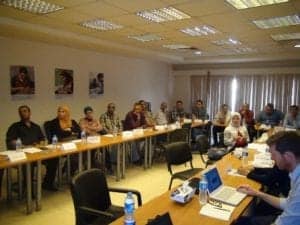Women’s World Banking is in the business of introducing new, innovative products tailored to the needs of low-income women with our partner institutions around the world. We’ve devoted a lot of attention to the more prominent aspects of product introduction in this blog: the market research, product design, marketing and consumer education, and even long-term monitoring of projects. What we haven’t talked about is what comes in between.
Question: How do you ensure that a new product is successful if you have hundreds of branches and thousands of employees?
Answer: Training.
Financial institutions must train their staff about the rationale for new products, how they work, and explain how to operate, market and promote the products, if they are to reach women. In 2015, Women’s World Banking developed 10 sales and product toolkits for financial institutions in Malawi, Tanzania, Nigeria, Uganda and Egypt among others. The training materials we’ve developed— for credit, microinsurance and savings—include tools that sales teams can use to show prospective clients how products work in a compelling way, and training-of-trainer materials to help our partner institutions cascade training across their branches.
Training as a tool for change management and integration

In addition, when an institution contracts with agents to open accounts and conduct transactions (for example, a shop owner who acts as a banking agent), bringing those agents to the head office for training can help integrate them into the organization’s culture. Making agents feel connected to the institution is critical because as customer facing representatives they need to communicate about the products and services with commitment and enthusiasm.
Everyone gets some… training
 Our approach to training development follows a comprehensive process: from the initial training-needs assessment, all the way through to the observations and assessments after the fact.
Our approach to training development follows a comprehensive process: from the initial training-needs assessment, all the way through to the observations and assessments after the fact.
Further, we believe that product and sales training should reach virtually everyone at an institution who has an involvement with a new product: those who are not directly involved also receive training and internal communications to enable them to serve as product champions both internally and externally. For the direct sales team, training must focus on acquiring, educating and engaging new customers, especially women. For branch managers, training focuses on coaching and managing sales teams to achieve targets. For head office staff, training focuses on the business case for new products and the link to the institutions’ growth strategies.
Each training session presents its own challenges and successes, and we continue to evolve and adapt our approach as we work with teams in a variety of settings. Nevertheless, we have three best practices for developing and executing trainings:
1. Training should be broken up into bite-sized pieces. Training should be broken down into small pieces that can be easily digested over the course of a week. With this approach, branches can continue to function while staff receive the knowledge they require to promote and operate a new product.
2. Technology-based training such as e-learning and mobile learning can enhance traditional face-to-face training. We are currently testing the possibility of delivering key messages from the training sessions to sales teams using SMS or e-flyers. This allows for continuous learning, providing reminders to sales teams about the key information they should communicate to clients. These technology-based reinforcements can take the place of physical sales tools, which some sales agents feel can create a physical barrier between them and the customer. When customers see agents reading from a book, that can also make them question the agent’s knowledge of the product. With SMS or e-flyers, when the agents are out in the field, they don’t have to disrupt the sales process to refer back to their notes or handouts.
3. Training assessments can be low-cost and user-friendly. We tend to think of pre- and post-training assessments as expensive to conduct, but we have been able to run surveys in low-cost ways using, for instance, Survey Monkey. It’s just as effective because the focus in on it’s about the design of the tool and having the right questions in the survey. In some cases, surveys with sales teams can be replaced with interviews and conversations with HR, Products and Learning and Development staff, who have experience training and managing sales teams and can provide insights to inform training content development.
Having a well-designed product is great, but without sales training, it will never reach its intended market.




